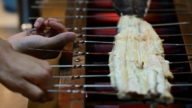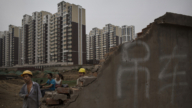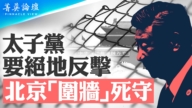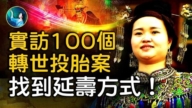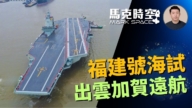【新唐人2013年12月23日讯】大陆货币市场的资金紧张情况不断加剧,银行间同业拆款利率升到6月份以来的最高水平。同时,“钱荒”压力也开始蔓延到其他市场。上海股市连续多日下跌,国债价格也不断下挫。为缓解危机,大陆央行再次向市场注入超过3,000亿人民币的流动性资金。下面请看报导。
12月19号,上海银行间7天期隔夜拆借利率一举突破7%的大关,此后更是连续攀升,让人感觉仿佛“钱荒”卷土重来。
大陆金融分析师任中道:“年底有各种银行的考核,还有财政存款的提取,所以它的钱就很紧张。”
大陆银行业手中无粮、年关难过的困境,不但导致银行间利率连创新高,股票证券市场也因此大受冲击、连续下跌。20号,大陆A股市场再度出现放量大跌,上证指数不仅击穿了2100点整数的关口,更是创下了罕见的9连跌。
在此之前,12月13号闭幕的中共中央经济工作会议,决定要维持稳健的货币政策,所以央行对于这次的钱荒,并没有立即出手救市。但随着危机的加剧,央行不得不再次放水注资。
20号,大陆央行表示,已连续三天,累计向市场注入超过3000亿元的流动性资金。央行指称,目前银行体系超额备付已超过1万5000亿元,为历史同期相对较高水平。外界分析,大量的资金投放市场,虽然可能使“钱荒”得到部分缓解,但也会增大物价上涨的压力。
任中道:“钱越多,那就说明越不值钱。物价会涨起来,然后通货膨胀就会更加的严重。”
北京《国情内参》期刊首席研究员巩胜利,也向《新唐人》表示,在正常国家里,货币投放增加之后,政府要设法通过发红包等方式来增加老百姓的收入,保证老百姓的生活水平。
北京《国情内参》首席研究员 巩胜利:“但是中国近64年以来,一直没有做过这样的事情。尽管货币投放量大,但是老百姓的收入没有增加。再加上人民币的贬值、对国内的贬值,所以可能会造成老百姓的生活水平有所下降。”
今年6月左右,大陆曾发生非常严重的“钱荒”,银行间隔夜拆借利率一度超过10%。后来,央行连续五周紧急投放3500多亿元资金,才使“钱荒”得到缓解。
巩胜利分析,大陆“钱荒”出现的关键领域是各国有企业、房地产、钢铁、能源等行业。人们无从知晓这背后的资金到底最终流向了何处。
巩胜利:“所以这些都是一些不确定的因素。不知道什么时候它可能会爆发,也不知道什么时候(需要)大笔的资金。它是市场经济国家没有的这种情况,因为它很多时候不在阳光下,你也看不到。”
巩胜利还谈到了央行这次投放货币的国际因素。他表示,美国已经决定减少美元投放量,这种情况下,中国就必须加大投放货币,才能保持人民币与美元的平衡。
据报导,18号“美联储(Fed)”对外宣布,从明年1月起,每月的购债金额将从850亿减到750亿美元,开始逐步停止“量化宽松”(Quantitative easing,简称QE)政策。
这表示,美国国债的收益率将上升,市场流动性资金紧缺,美元汇率走高,因此美国市场以外的资金开始回流美国本土,中国大陆境内的热钱很可能会减少,“钱荒”加剧。
而任中道则指出,其实中国大陆的“钱荒”是一直存在的,只是有时候更严重一些。中共目前对钱荒的处理是进退两难。央行放水注资的做法也是治标不治本,中国大陆的“钱荒”将一直持续下去。
采访/易如 编辑/李谦 后制/萧宇
China central bank injects more on cash crunch
China is experiencing a severe cash shortage,
and interbank borrowing costs have risen to their highest
since June this year.
The cash crunch has extended to other markets as well.
Shanghai stocks have been falling for several days and
bond prices have also continued to fall.
To ease the crisis, China’s central bank has again injected over
300 billion yuan ($49.2 billion) of liquidity into the market.
Here’s the report.
On Dec. 19, Shanghai’s short-term liquidity borrowing cost,
or the seven-day repurchase agreement rate,
broke the 7 % benchmark.
The continued rise seems like
a reoccurrence of this summer’s cash crunch.
Ren Zhongdao, financial analyst: “The liquidity squeeze was
caused by the year-end assessment and banks’ fiscal deposits
getting withdrawn."
This cash crunch in the banks at the end of year has created
new high in interest rates and hit the stock market hard.
On Dec. 20, China’s Shanghai Composite Index dipped
below 2,100 points, and moved down for
nine consecutive days as of Friday.
During the Central Economic Work Conference, which ended
on Dec. 13, the Chinese Communist regime decided to
maintain a prudent monetary policy.
China’s central bank did not react immediately to the money
shortage until the problem recently got serious and the
central bank decided to inject liquidity again.
On Dec. 20, China’s central bank said more than
300 billion yuan of liquidity had been injected to the market
over three days.
The central bank says that the banking system has
excess reserves of over 1.5 trillion yuan ($247 billion),
which is considered to be a relatively high level.
Analysts say that mass liquidity will relieve some of the
cash crunch, but also increases the likelihood of inflation.
Ren Zhongdao: “More liquidity means less value.
Prices will go up and inflation will be more severe."
Beijing-based senior journalist Gong Shengli tells NTD
that an ordinary government will normally ensure the
living standard by issuing benefits to increase people’s income
after injecting liquidity.
Gong Shengli, senior Beijing journalist: “But for nearly the
past 64 years, China has not done that.
Though much liquidity was injected,
the general public’s earnings did not increase.
[China’s standard of living] falls further
with the depreciation of the yuan."
In June, the Chinese interbank rate surged to 10 percent
overnight because of the cash squeeze.
The situation only eased up after the central bank made an
emergency injection of more than 350 billion yuan ($58 billion)
over five consecutive weeks.
Gong Shengli says that this cash shortage shows up in several
key sectors, such as China’s state owned enterprises,
the real estate, steel, and energy industries and so on.
No one has any idea where all the money has ended up.
Gong Shengli: “There are some uncertain factors.
No one knows when the crisis will happen and
when the money is needed.
This is something free market countries do not experience.
We don’t see it [the money] because it’s not out in the open."
Gong Shengli also says there is an international factor in the
central bank’s decision to inject liquidity.
He says the U.S. has decided to reduce injections,
and so China has to inject large amounts of money
to keep a balance between the dollar and the yuan.
According to Dec. 18 reports, the U.S. Federal Reserve
will reduce monthly purchases of assets from $85 billion to
$75 billion to phase out the Quantitative Easing program.
This means that U.S. Treasury yields will rise,
market liquidity will run short, and the dollar will rise.
Thus overseas capital will return to the U.S., and the
hot money in mainland China may reduce,
resulting in a tighter cash crunch for mainland China.
Ren Zhongdao says that the cash squeeze has always existed
in China, it’s only a matter of the severity.
China’s Communist regime faces a dilemma
over handling the cash crunch.
Since the central bank’s injecting liquidity will not solve the
fundamental issue, the cash crunch in China can only continue.
Interview/Yiru Edit/LiQian Post-Production/XiaoYu


